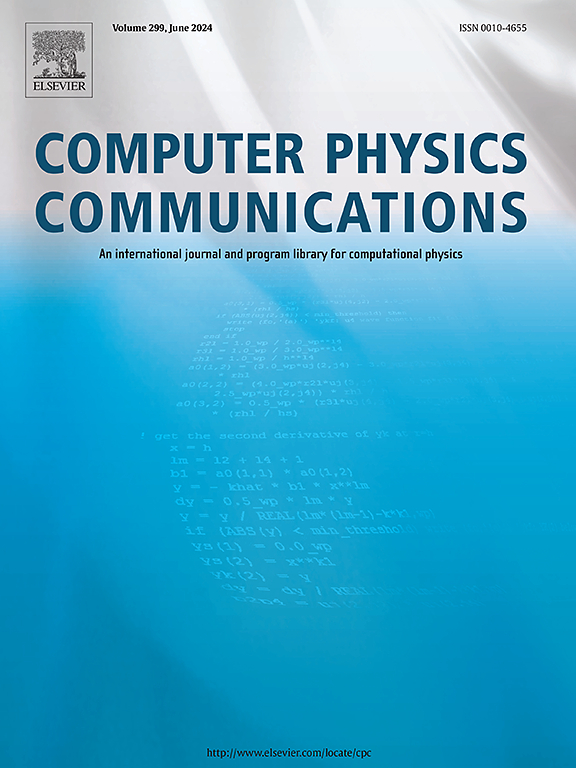复杂尺度光学和库仑散射求解器
IF 3.4
2区 物理与天体物理
Q1 COMPUTER SCIENCE, INTERDISCIPLINARY APPLICATIONS
引用次数: 0
摘要
我们介绍COLOSS,一个程序,旨在解决散射问题,使用一种被称为复杂缩放的束缚态技术。在这种方法中,波函数的振荡边界条件被转化为指数衰减的边界条件,以适应远距离库仑相互作用。该程序实现了一般的局部光势和Perey-Buck非局部光势,所有的电位参数都包含在一个设计良好的输入格式中,便于使用。该设计为用户提供了直接访问计算s矩阵和散射过程的横截面,涉及任何自旋弹丸与自旋为0的目标相互作用。我们对拉格朗日函数的精度及其在计算矩阵元素中的好处进行了深入的讨论。此外,COLOSS结合了两种不同的旋转方法,使其适用于没有解析表达式的电位。对比结果表明,与直接积分法Numerov相比,COLOSS具有较高的精度,突出了其在散射计算中的实用性和有效性。程序摘要程序标题:COLOSSCPC库链接到程序文件:https://doi.org/10.17632/ph4m98rpv2.1Developer's存储库链接:https://github.com/jinleiphys/COLOSSLicensing条款:gplv3编程语言:fortran问题的性质:核之间弹性散射的研究是核物理学中的一个基本问题,是理解核相互作用和结构的关键。在这种情况下,求解Schrödinger方程的传统方法通常需要在很远的距离上施加边界条件,这在计算上具有挑战性,并且容易出现不准确性,特别是对于涉及强库仑相互作用和复杂势的反应。复杂标度方法通过将散射波函数从振荡形式转换为指数衰减形式,从而消除了对边界条件的需要,提供了一种鲁棒的替代方法。然而,实现这种方法需要仔细的数值处理和验证所涉及的势的解析性质,如复平面上的Woods-Saxon函数。此外,确保不同旋转技术和集成方法的数值稳定性和精度至关重要。本研究通过开发一个程序来解决这些挑战,该程序利用复杂的缩放方法,为计算原子核之间的弹性散射提供了一个灵活而准确的工具。该程序处理各种光学模型电位的能力及其对Numerov等既定方法的验证强调了其在核物理研究中的实用性和可靠性。求解方法:为了解决计算核间弹性散射的难题,我们采用复标度法,通过将径向坐标转换为复平面,将Schrödinger方程转换为简化边界条件。这个变换把波函数从振荡变成指数衰减。我们的方法包括对传统方法(如Numerov算法)的结果进行验证,以确保准确性。此外,我们开发了一个灵活的计算程序,能够处理各种光学模型势,如Woods-Saxon势,并有效地执行复杂的缩放和集成。该方法为研究核物理中的弹性散射提供了一种鲁棒性、准确性和计算效率高的解决方案。附加注释,包括限制和不寻常的功能:我们的方法虽然有效,但也有一些限制和不寻常的功能。复杂的标度方法需要小心处理,以避免数值不稳定,特别是在大径向距离。选择高斯-勒让德正交是因为它的收敛性,需要精确地选择点和权值。计算程序处理各种光学模型势(如Woods-Saxon势)的灵活性增加了复杂性,需要彻底验证。此外,大规模模拟可能需要大量的计算资源。尽管存在这些挑战,我们的方法为核物理中的弹性散射提供了精确和有效的解决方案,尽管用户必须小心潜在的数值不稳定性和复杂性。本文章由计算机程序翻译,如有差异,请以英文原文为准。
COLOSS: Complex-scaled Optical and couLOmb Scattering Solver
We introduce COLOSS, a program designed to address the scattering problem using a bound-state technique known as complex scaling. In this method, the oscillatory boundary conditions of the wave function are transformed into exponentially decaying ones, accommodating the long-range Coulomb interaction. The program implements the general local optical potential and the Perey-Buck non-local optical potential, with all potential parameters included in a well-designed input format for ease of use. The design offers users direct access to compute S-matrices and cross-sections for scattering processes involving a projectile of any spin interacting with a spin-0 target. We provide thorough discussions on the precision of Lagrange functions and their benefits in evaluating matrix elements. Additionally, COLOSS incorporates two distinct rotation methods, making it adaptable to potentials without analytical expressions. Comparative results demonstrate that COLOSS achieves high accuracy when compared with the direct integration method, Numerov, underscoring its utility and effectiveness in scattering calculations.
Program summary
Program Title: COLOSS
CPC Library link to program files: https://doi.org/10.17632/ph4m98rpv2.1
Developer's repository link: https://github.com/jinleiphys/COLOSS
Licensing provisions: GPLv3
Programming language: Fortran
Nature of problem: The study of elastic scattering between nuclei is a fundamental problem in nuclear physics, key to understanding nuclear interactions and structure. Traditional methods for solving the Schrödinger equation in such contexts often require imposing boundary conditions at large distances, which can be computationally challenging and prone to inaccuracies, especially for reactions involving strong Coulomb interactions and complex potentials. The complex scaling method offers a robust alternative by transforming the scattered wave function from an oscillatory to an exponentially decaying form, thus eliminating the need for boundary conditions. However, implementing this method requires careful numerical handling and validation of the analytic properties of the involved potentials, such as the Woods-Saxon function, on the complex plane. Additionally, ensuring numerical stability and accuracy across different rotational techniques and integration methods is crucial. This study addresses these challenges by developing a program that leverages the complex scaling method, providing a flexible and accurate tool for calculating elastic scattering between nuclei. The program's ability to handle various optical model potentials and its validation against established methods like Numerov underscores its utility and reliability in nuclear physics research.
Solution method: To address the challenges in calculating elastic scattering between nuclei, we utilize the complex scaling method, which transforms the Schrödinger equation to simplify boundary conditions by converting the radial coordinate into the complex plane. This transformation changes the wave function from oscillatory to exponentially decaying. Our approach includes validating results against traditional methods like the Numerov algorithm to ensure accuracy. Additionally, we develop a flexible computational program capable of handling various optical model potentials, such as the Woods-Saxon potential, and performing complex scaling and integration efficiently. This method provides a robust, accurate, and computationally efficient solution for studying elastic scattering in nuclear physics.
Additional comments including restrictions and unusual features: Our method, while effective, has some restrictions and unusual features. The complex scaling method requires careful handling to avoid numerical instabilities, especially at large radial distances. Gauss-Legendre quadrature, chosen for its convergence, demands precise selection of points and weights. The computational program's flexibility to handle various optical model potentials, like the Woods-Saxon potential, adds complexity and requires thorough validation. Additionally, large-scale simulations may require significant computational resources. Despite these challenges, our approach provides precise and efficient solutions for elastic scattering in nuclear physics, though users must be cautious of potential numerical instabilities and complexities.
求助全文
通过发布文献求助,成功后即可免费获取论文全文。
去求助
来源期刊

Computer Physics Communications
物理-计算机:跨学科应用
CiteScore
12.10
自引率
3.20%
发文量
287
审稿时长
5.3 months
期刊介绍:
The focus of CPC is on contemporary computational methods and techniques and their implementation, the effectiveness of which will normally be evidenced by the author(s) within the context of a substantive problem in physics. Within this setting CPC publishes two types of paper.
Computer Programs in Physics (CPiP)
These papers describe significant computer programs to be archived in the CPC Program Library which is held in the Mendeley Data repository. The submitted software must be covered by an approved open source licence. Papers and associated computer programs that address a problem of contemporary interest in physics that cannot be solved by current software are particularly encouraged.
Computational Physics Papers (CP)
These are research papers in, but are not limited to, the following themes across computational physics and related disciplines.
mathematical and numerical methods and algorithms;
computational models including those associated with the design, control and analysis of experiments; and
algebraic computation.
Each will normally include software implementation and performance details. The software implementation should, ideally, be available via GitHub, Zenodo or an institutional repository.In addition, research papers on the impact of advanced computer architecture and special purpose computers on computing in the physical sciences and software topics related to, and of importance in, the physical sciences may be considered.
 求助内容:
求助内容: 应助结果提醒方式:
应助结果提醒方式:


